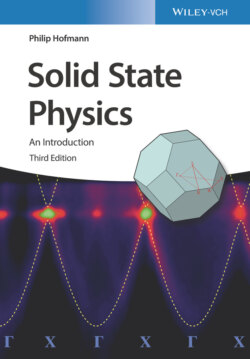Читать книгу Solid State Physics - Philip Hofmann - Страница 27
1.3.1.7 The Ewald Construction
ОглавлениеIn 1913, P. Ewald published an intuitive geometrical construction to visualize the Laue condition [Eq. (1.25)] and to determine the directions for which constructive interference is to be expected. The construction is shown in Figure 1.12, which represents a cut through the reciprocal lattice; the black points are the reciprocal lattice points. The construction works as follows:
1 We draw the wave vector of the incoming X‐rays such that it ends in the origin of the reciprocal lattice (we may of course choose the point of origin freely).
2 We construct a circle of radius around the starting point of .
3 Wherever the circle touches a reciprocal lattice point, the Laue condition is fulfilled.
Figure 1.12 Ewald construction for finding the directions in which constructive interference can be observed. The dots represent the reciprocal lattice. The arrows labeled and are the wave vectors of the incoming and scattered X‐rays, respectively.
For a three‐dimensional crystal, this construction has to be carried out in different planes, of course. The figure clearly shows that Eq. (1.25) is a very stringent condition: It is not likely for the sphere to hit a second reciprocal lattice point, which means that constructive interference is expected for very few directions. As in the Bragg description, we see that the wavelength of the X‐rays has to be sufficiently small ( has to be sufficiently large) for any constructive interference to occur.
Practical X‐ray diffraction experiments are often carried out in such a way that many constructive interference maxima are observed despite the strong restrictions imposed by the Laue condition, Eq. (1.25). For example, this can be achieved by using a wide range of X‐ray wavelengths, i.e. non‐monochromatic radiation, or by performing a diffraction experiment not on a single crystal but on a powder of randomly oriented small crystals.
